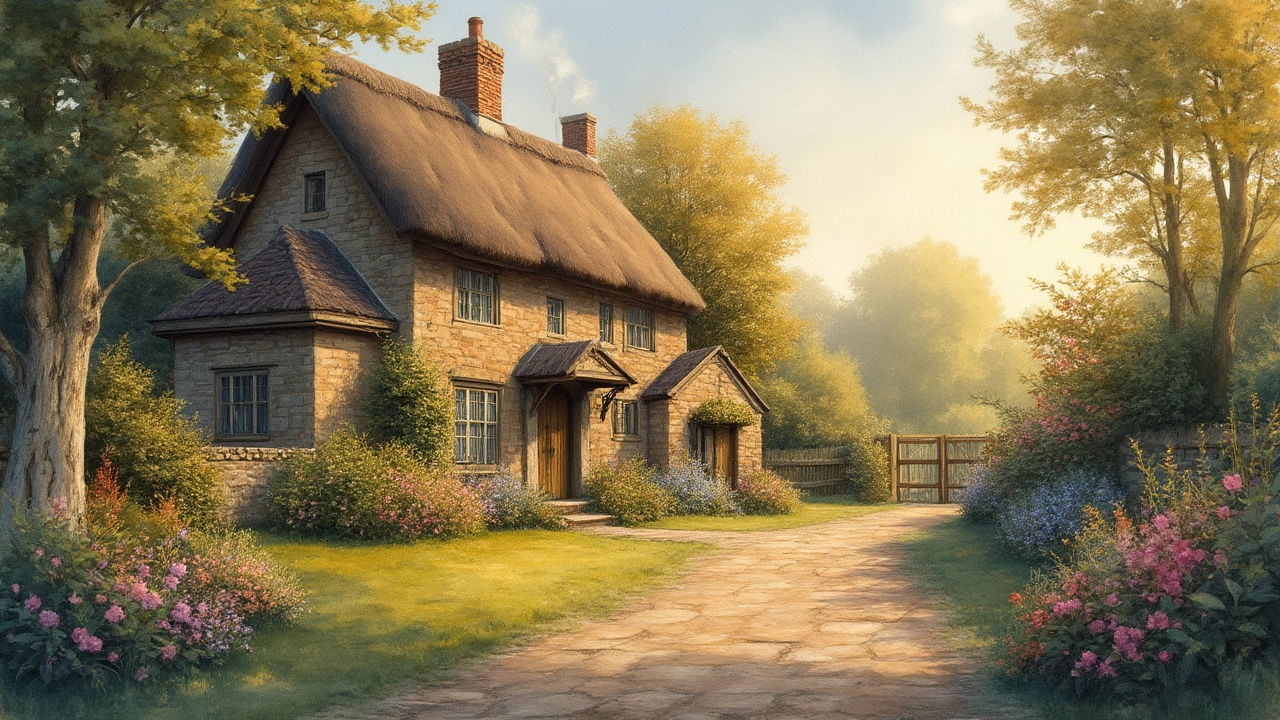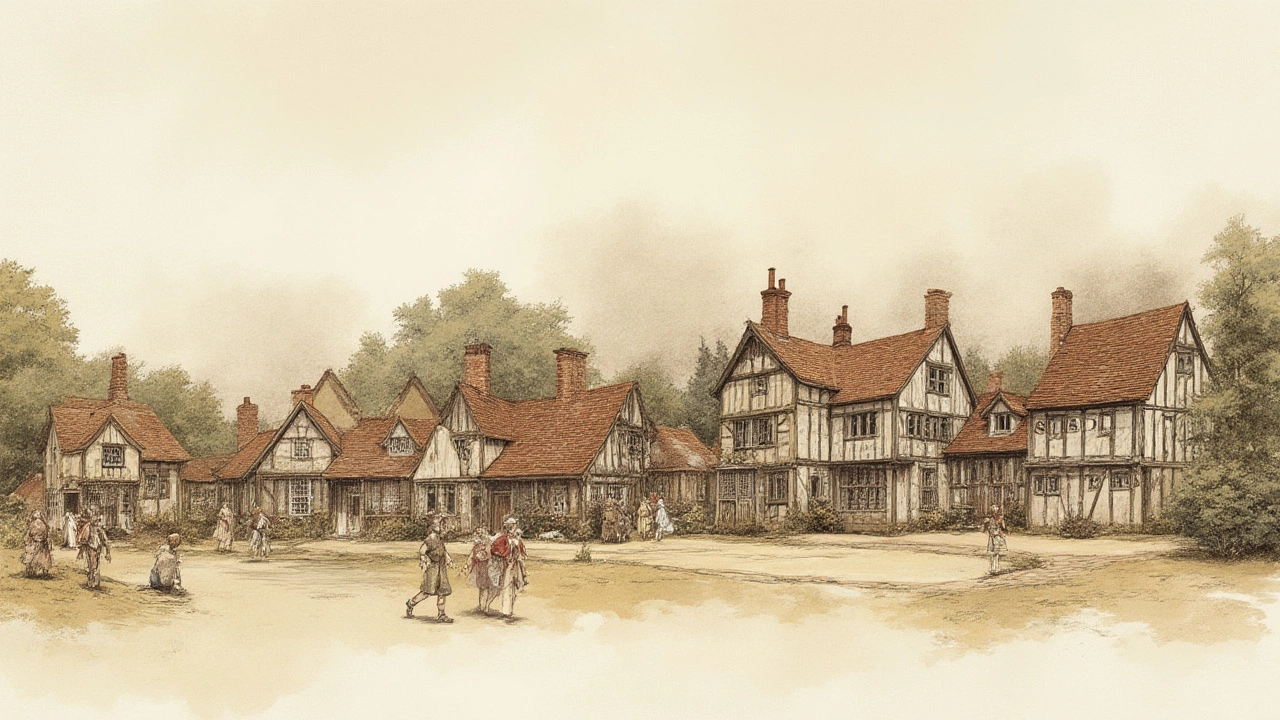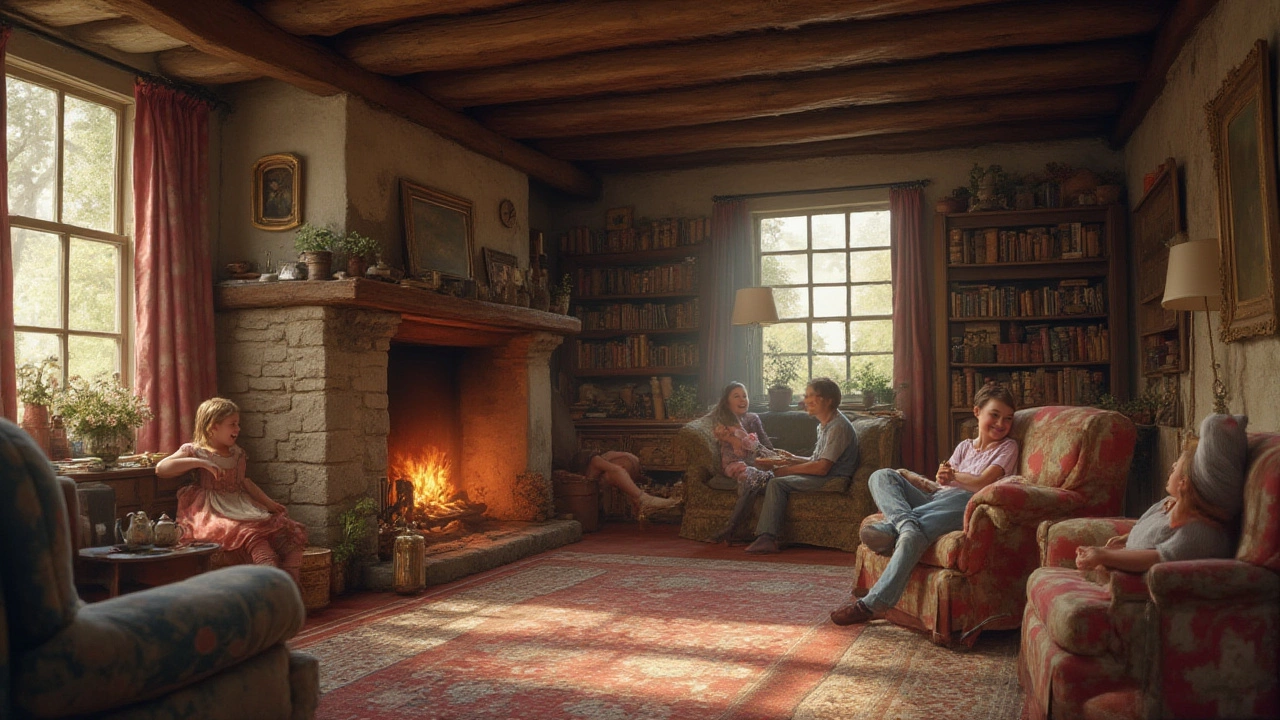The Story Behind Cottage Names: Origins, Meaning, and Charm
 Jul, 15 2025
Jul, 15 2025
Imagine pulling up to a little house with smoke curling out of a stone chimney and wildflowers bobbing along the front. Now tell me you didn’t just picture a cottage. The word alone seems to spark something cozy and storybook in most of us, even if we grew up nowhere near the English countryside. But how did this word, with all its rustic magic, get stuck to small homes for getaways or rural life? The secret is both less glamorous and even more interesting than you might guess.
Where the Word 'Cottage' Comes From
The term ‘cottage’ rolls off our tongues with such comfort, but it has roots way back in medieval England. Think peasants, fields, and lords, not tea and scones. In fact, ‘cottage’ first showed up around the 13th century. Linguists trace it back to the Old English word ‘cot’—meaning a small hut or shelter. This word traveled over from the Old Norse ‘kot’, so it’s even sprinkled with a dash of Viking.
Originally, a ‘cottage’ was more than just a building. It described a whole way of life. A medieval cottage wasn’t some dreamy weekend retreat; it housed a ‘cotter’ and their family—workers who held a little land rented from a landlord. In exchange for a patch of earth, cotters would provide labor to the local lord. Unlike regular farm workers, cotters usually had a plot just big enough for a garden and a few animals, so their homes were always modest. They were the backbone of rural European life for centuries. And yes, these humble origins stuck—the ‘cottage’ always meant something small and lived-in.
What’s interesting is how the meaning of ‘cottage’ shifted through time. By the 18th and 19th centuries in England, cottages turned into symbols of rural charm. Instead of being solely worker’s housing, they started to catch the eye of artists and poets who painted them as romantic escapes from busy city life. These cozy spots popped up in everything from sweet children’s books to breathless travel diaries. Suddenly, ‘cottage’ didn’t just mean a tiny, simple house. It meant a place of peace.
How Cottages Became Holiday Homes
Here’s a twist no one saw coming: the word ‘cottage’ moved from practical worker’s homes to the heart of holiday dreams. As people began escaping the city during the Industrial Revolution, they weren’t climbing into downtown apartments or sprawling manors—they wanted a taste of the countryside in a little, rustic house. So, they rented the humble cottages of departing rural folks, and the tradition of cottage holidays was born.
By the 20th century, especially in the UK, to ‘go to the cottage’ became a thing. Wealthy Victorians snapped up old farm cottages for summer getaways, and middle-class families soon followed. This way of holidaying shot off across the world. Over in Canada, ‘the cottage’ came to mean a lakeside hideaway. Australians call it a ‘bush retreat’ or ‘holiday shack,’ and the French word—‘cottage’—entered English straight from the French countryside ‘cottage’ scene. It’s a truly global idea now, but the basic premise hasn’t changed: a small, characterful house where you ditch your worries and get back to basics.
What’s fascinating is how the idea of a cottage gets mixed up with nostalgia. Even in 2025, with digital door locks and speedy Wi-Fi, people still want cottages to feel full of old-world charm. You’ll see it in holiday listings everywhere—original beams, roaring fires, rough plaster. If you polled guests, most would say they choose a cottage for the atmosphere. A report by VisitBritain in 2023 showed that over 65% of UK holidaymakers preferred self-catering rentals like cottages, just for the escape from city life.

Global Variations: Not Just an English Thing
Although the word ‘cottage’ started in Britain, the basic idea landed all over the world. You might not find a thatched roof in Norway’s fjords, but you will spot log cabins that are basically northern cousins to the classic British cottage. Finland calls them ‘mökki,’ and they carry the same spirit—simple, rural, a place to unplug. Even the Toolshed Cottage in Ireland or a ‘bothy’ in Scotland carry the same cozy DNA.
Here’s a fun fact: in Russia, the ‘dacha’ is a holiday home on the city’s edge, no matter how grand or basic. They often feature veg patches, creaky doors, and mismatched furniture, just like their English counterparts, and the word ‘dacha’ has almost the same emotional pull as ‘cottage.’ Across the Atlantic in Canada, cottages mean hammocks by lakes, canoe trips, and grilling by open fires. About 15% of Canadian families have access to a cottage or other seasonal property, according to the Canadian Real Estate Association in 2023.
The design and material may differ—a Greek island ‘cottage’ is all whitewashed stone and bright blue shutters, while New Zealand’s version is a rustic bach by the sea—but the idea is the same: somewhere small and full of character, outside the city. There’s even a wave of ‘urban cottages’ now, with city homeowners recreating that snug vibe using clever design tricks, like painted beams or wood-burning stoves.
| Country | Local Cottage Name | Key Features |
|---|---|---|
| England | Cottage | Stone or brick, thatched or slate roofs, small gardens |
| Canada | Cottage/Cabin | Lakeside, wooden, fireplaces, screened porches |
| Finland | Mökki | Log-built, saunas, near lakes or forests |
| Russia | Dacha | Vegetable plots, rural or suburban, often rustic |
| Greece | Exochiko | Whitewashed stone, sea views, blue shutters |
| New Zealand | Bach | Beachside, simple, weatherboard |
Cottage Styling and What Makes a Home a ‘Cottage’?
If you’re hunting for the perfect holiday home, just calling a place a ‘cottage’ isn’t enough—it takes the real details. Picture low ceilings, exposed wooden beams, maybe even an uneven floor or nooks where kids disappear for hide-and-seek (my daughter Ainsley can sniff out a window seat in 2.5 seconds flat). Some cottages dazzle with period quirks: an old bread oven in the kitchen, a dog-leg staircase, or a stone inglenook big enough for you and a couple of tired border collies.
Modern cottage style isn’t about fancy or flawless. Instead, it’s about worn smooth surfaces, practical design, and a touch of whimsy. A cottage might have mismatched china, handmade quilts, or battered wellies in the hall. If you find a state-of-the-art spa bathroom and glass walls, you’re in the wrong place—save it for a spa hotel, not a cottage.
Here are clues you’ve found the real thing:
- Size: Cottages are usually one to two stories, with just a few bedrooms.
- Materials: Natural. Stone, brick, timber, or even cob. Modern imitations use reclaimed or faux materials.
- Setting: Cottages should tuck into nature—on the edge of a field, by water, or down a wandering lane.
- Atmosphere: It’s that intangible ‘something’—a combination of snuggly spaces, aged wood, and the feeling that you can properly switch off.
The recent trend for ‘cottagecore’ on social media has sparked a fresh wave of interest, especially with home décor and lifestyle influencers swooning over everything rustic. In 2024, #cottagecore was trending on Instagram, racking up over 13 million posts worldwide. People are drawn to this as an antidote to the relentless buzz of the modern world—who wouldn’t want a corner of calm?

Tips for Choosing or Creating Your Own Cottage Retreat
So you want a slice of cottage life—or just want your holiday rental to hit all the right notes? Easy. It doesn’t have to be perfect; if anything, a real cottage should feel a little bit wonky. But there are ways to make it magic:
- Bring the Outside In: Fill the house with wildflowers or potted plants. Raw wood and stone surfaces are your friends.
- Snuggly Textiles: Aim for blankets, old quilts, and cushions in rich, comforting fabrics.
- Keep Lighting Low: Swap out harsh overhead lights for lamps and candles. Fairy lights aren’t just for Christmas if you ask me or Ainsley.
- Mix and Match: Forget matching furniture. The best cottages have a bit of everything collected over time.
- Embrace Little Quirks: That odd corner or tiny window? Perfect. The stranger the better, honestly.
- Outdoor Nooks: Even a postage-stamp patio with a battered bench and herb pots feels right.
- Simple Luxury: Treat yourself to fluffy towels and real soap, but forget the five-star polish.
When choosing a cottage rental, ask the host about real features (wood-burning stove, old beams, original floors) and poke around reviews for mention of that set-apart, joyful feel. Personally, I always look for cottages with stories—ones that might have been a blacksmith’s place once or where great-grandparents held barn dances. It just gives the holiday a bit more flavor.
If you’re turning your own home into a cottagey retreat, don’t think you need to over-renovate. Often less is more. Add thrift shop finds, hang a landscape painting, keep the tech hidden, and let the place breathe. Kids pick up on this, too; the more relaxed the space, the more freely they play. At our last getaway, Ainsley announced she’d write a book about the garden foxes—cottage magic at work, trust me.
One last thing—don’t get precious about perfection. Cottages have always been about making do, feeling content, and celebrating the simple life. If it looks a little rough around the edges, you’re doing it right.
The next time you hear someone talk about that word—cottage—picture not just a building but a whole stretch of human history, from medieval field workers to TikTok daydreamers, each one craving their own pocket-sized patch of peace. If that’s not the perfect holiday home, what is?
